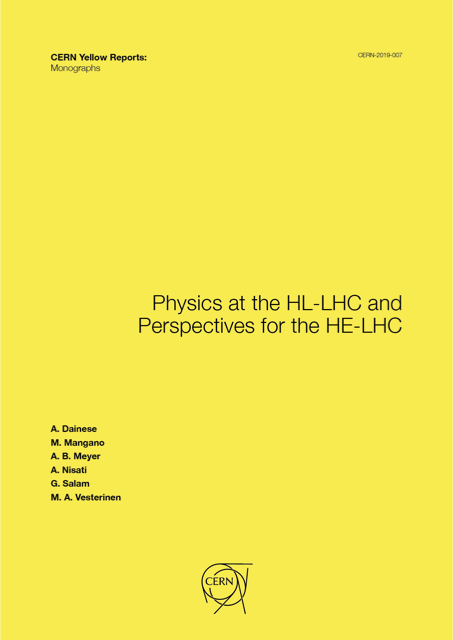Beyond the Standard Model physics at the HL-LHC and HE-LHC
DOI:
https://doi.org/10.23731/CYRM-2019-007.585Abstract
This is the third out of five chapters of the final report [1] of the Workshop on Physics at HL-LHC, and perspectives on HE-LHC [2]. It is devoted to the study of the potential, in the search for Beyond the Standard Model (BSM) physics, of the High Luminosity (HL) phase of the LHC, defined as $3$ ab$^{-1}$ of data taken at a centre-of-mass energy of 14 TeV, and of a possible future upgrade, the High Energy (HE) LHC, defined as $15$ ab$^{-1}$ of data at a centre-of-mass energy of 27 TeV. We consider a large variety of new physics models, both in a simplified model fashion and in a more model-dependent one. A long list of contributions from the theory and experimental (ATLAS, CMS, LHCb) communities have been collected and merged together to give a complete, wide, and consistent view of future prospects for BSM physics at the considered colliders. On top of the usual standard candles, such as supersymmetric simplified models and resonances, considered for the evaluation of future collider potentials, this report contains results on dark matter and dark sectors, long lived particles, leptoquarks, sterile neutrinos, axion-like particles, heavy scalars, vector-like quarks, and more. Particular attention is placed, especially in the study of the HL-LHC prospects, to the detector upgrades, the assessment of the future systematic uncertainties, and new experimental techniques. The general conclusion is that the HL-LHC, on top of allowing to extend the present LHC mass and coupling reach by $20-50\%$ on most new physics scenarios, will also be able to constrain, and potentially discover, new physics that is presently unconstrained. Moreover, compared to the HL-LHC, the reach in most observables will, generally more than double at the HE-LHC, which may represent a good candidate future facility for a final test of TeV-scale new physics.Downloads
Published
2019-12-03
Issue
Section
Articles
License
Authors who publish with this publication agree to the following terms:
- CERN retains copyright and publishes the work licensed under the Creative Commons Attribution License 4.0 that allows others to share the work with an acknowledgement of the work's authorship and initial publication in this series.
- Authors are able to enter into separate, additional contractual arrangements for distribution of the published version of the work (e.g., post it to an institutional repository or publish it in a book), with an acknowledgement of its initial publication in this series.
- Authors are permitted and encouraged to post their work online (e.g., in institutional repositories or on their website) prior to and during the submission process, as it can lead to productive exchanges, as well as earlier and greater citation of published work (See The Effect of Open Access).

